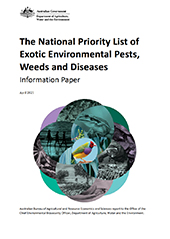In November 2020, the department released the National Priority List of Exotic Environmental Pests, Weeds and Diseases. This is also called the Exotic Environmental Pest List (EEPL). Explore detailed information about the development and scope of the EEPL on this page.
Development
The development of the EEPL was a key recommendation of the 2017 report, ‘Priorities for Australia’s biosecurity system’. The National Biosecurity Committee endorsed the final EEPL in October 2020. It was released in November 2020.
The National Priority List of Exotic Environmental Pests, Weeds and Diseases Information Paper
This information paper includes full details about the development of the EEPL.
The Australian Bureau of Agricultural and Resource Economics and Sciences (ABARES) and the department led the development of the EEPL. This involved extensive consultation.
Criteria for pests
Species listed on the EEPL must meet four criteria.
- Be a pest, disease or weed that has potential for or demonstrated negative impacts on the environment or social amenity.
- Be exotic to Australia. (That is, not currently known to be present in Australia or, if present, subject to nationally agreed eradication).
- Have at least one known or potential pathway of entry to Australia.
- Have the potential to establish and spread in Australia.
Governance
The Australian Chief Environmental Biosecurity Officer (ACEBO) is the custodian of the EEPL. The ACEBO administers its use and manages any ad hoc and planned reviews.
The Environment and Invasives Committee (EIC) has policy oversight of the EEPL. When developing, reviewing, and amending the EEPL, the EIC will consult with:
- Plant Health Committee
- Animal Health Committee
- Marine Pest Sectoral Committee
- other relevant stakeholders as appropriate.
The entire EEPL list is scheduled for review every 5 years. The EEPL can also be updated outside of this review cycle. This may occur if new information becomes available about the consequences of a pest establishing.
Scope
The EEPL does not list all organisms that pose an environmental biosecurity risk to Australia. However, the list is broad. Any unlisted risk species will likely fit within one of the 8 biological groups in the EEPL. Any measures to reduce the risk posed by that biological grouping will likely reduce the risk posed by listed and unlisted species alike.
Species may have been excluded from the EEPL because:
- they are unlikely to enter Australia,
- there is unsuitable habitat and/or climate
- they have no known hosts in Australia
- too little is known about them or their potential impacts in Australia
- they are allowed to be privately kept by state or territory laws (this does not include species in zoos)
- they are already established in Australia.
Some species on the list are under official eradication and are still classed as exotic rather than established.
If a species is no longer under eradication and starts being ‘managed’, it would no longer meet the criteria for the list. It will be removed when the list is next reviewed.
Relationship to other priority lists
A number of EEPL species also appear in other priority lists. They are listed in the EEPL to encourage risk reduction measures specifically focussed on the environmental outcomes.
Other national priority lists include:
- National list of notifiable animal diseases
- National list of reportable diseases of aquatic animals
- National priority plant pest list
- Australian priority marine pest list
Other lists developed in Australia include (but are not limited to):
- Live import list
- Weeds of National Significance
- List of exotic vertebrates in Australia
- Northern Australia Quarantine Strategy (NAQS) target list (pests, diseases and weeds)
State and territory governments also have priority pest lists.
Stay in touch
Join our mailing list to stay up to date on environmental biosecurity news, including information on the EEPL. Email acebo@aff.gov.au

